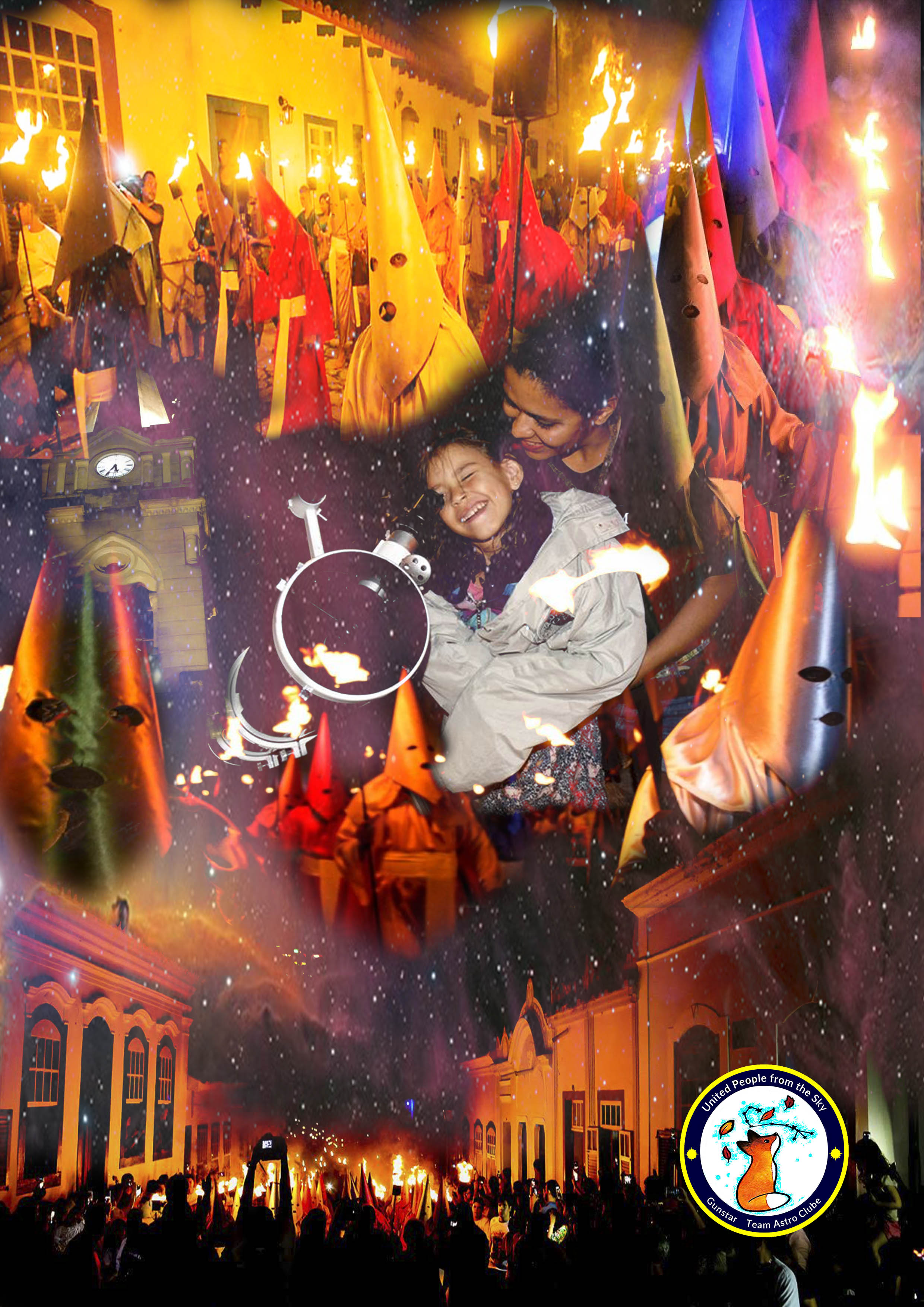Report
Gunstar invites everyone to a super adventure of the global month of Astronomy 2019.
With the largest project of dissemination of astronomy and practical observation in Goias the traveling telescope we will be observing the moon and with equipments for the great public to have their first with astronomy or with practical observation.
The procession stages the prison of Jesus Christ and begins at 0:00 on Holy Thursday, with the public lighting turned off and the sound of drums, at the door of the Church of the Good Death, in the main square of the city. Traditionally, 40 Farricocos dressed in special attire and holding torches, represent Roman soldiers. They follow barefoot, through the old stone streets of the city [1]. A crowd of people, faithful, tourists and locals, attend the spectacle, marching along the Farricocos towards the staircase of the Church of N. S. of the Rosary, where they find the table of the last supper already dispersed. Then they advance towards the Church of San Francisco de Paula, which symbolizes the Garden of Olives, where the arrest of Christ will take place. This is represented by a linen banner painted on two sides by the 19th century artist Veiga Valle. The dress worn by the Farricocos is characterized by a long tunic of varied colors and by a long conical and pointed hood, keeping strong similarities with the garments that still today are common in the celebrations of the holy week in Spain. It is, in fact, an outfit of medieval origin, which was customarily used by penitents who could atone for their sins without having to publicly reveal their identity.
The municipality was recognized in 2001 by UNESCO as World Heritage and Cultural Heritage for its peculiar baroque architecture, for its secular cultural traditions and for the exuberant nature that surrounds it.
Before the arrival of the Europeans to the American continent, the central portion of Brazil was occupied by Indians of the linguistic trunk macro-jê, such as acroás, xacriabás, xavantes, caiapós, javaés, etc. [8]
On the one hand, the Minas Gerais on one side and the Cuiabá mines on the other, in the 17th century, a Renaissance idea (that the precious metal laths disposed parallel to the equator) would feed into the hypothesis that these two points, there would also be the same gold. As a result, the Bandeirantes invaders, mainly from São Paulo, were intensified in Goian territory, culminating both with the discovery and appropriation of the gold mines of the Goias Indians, which would be extinguished there faster than the metal itself. There, where the Goian nation lived, Bartolomeu Bueno da Silva would found the Arraial de Sant'Anna in 1729. [1] [9]
A little more than a decade later, in 1736, the place would be elevated to the condition of administrative town, with the name of Vila Boa de Goyaz (archaic spelling). At this time, still belonged to the Captaincy of São Paulo. In 1748, the Captaincy of Goiás was created, but the first governor, Dom Marcos de Noronha, the Count of Arcos, would only arrive there five years later.
With it, a "minimal state" was installed and, soon, the town becomes capital of the region. Noronha then had to build the Foundry House in 1750 and the Palace that would take his name (Conde dos Arcos) in 1751. Decades later, another governor - Luís da Cunha Meneses, who was in charge of 1778 to 1783-, creates important landmarks, making the afforestation of the village, aligning streets and establishing the first plan of urban planning that outlined the structure maintained until today.
With the depletion of gold, at the end of the 18th century, Vila Boa had its population reduced and needed to reorient its economic activities to agriculture, but still culturally and socially it was always in tune with the fashions of Rio de Janeiro, then capital of the Empire. From then until the beginning of the 20th century, the main manifestations would be art and culture, with sarai, jograis, plastic arts, literature, cooking and ceramics - as well as a unique ritual in Brazil, the Fogaréu Procession, held in Holy Week.
However, the great change, which had already been aired for a long time, was the transfer of the state capital to Goiânia, in the thirties and forties, coordinated by the then intervener of the State, Pedro Ludovico Teixeira. In a way, it was this decision that preserved the unique and exclusive colonial architecture of the city of Goiás.
2 major events in Goias are:
The International Festival of Environmental Film and Video (FICA) is a festival held annually in the city of Goiás since 1999. It is currently the largest film festival on the environment. Its accomplishment is in charge of the Goian Agency of Culture Pedro Ludovico Teixeira (Agepel). In its first year of implementation, 1999 FICA took place between June 2 and 6. There were 154 entries from 17 countries. Of these, 37 productions (4 Feature films, 12 Medium-length films and 21 Short films) were selected from 12 countries: Argentina, Austria, Brazil, Denmark, Spain, United States, France, Holland, England, Mozambique, Portugal and Venezuela. In the Brazilian participation, 17 works from 8 states were selected: Brasília, Goiás, Maranhão, Pernambuco, Rio de Janeiro, Santa Catarina and São Paulo
Procession of Fogaréu: One of the most beautiful religious manifestations that happen in the City of Goiás annually is the Procession of Fogaréu, that begins at the midnight of the Wednesday of the holy week. On this day, the scenarios on the Passion of Christ move the locality, which accompanies everything with devotion and a certain curiosity. The celebration, which continues a tradition of a little more than 200 years, consists of staging the main biblical passages that precede the crucifixion of Jesus through the streets of Goias, of which the Fogo Procession forms part. In it, the farrious men, hooded men in colored robes, carry torches burning among the dark streets, representing the way of the Romans until the moment of the arrest of Christ. On Thursday and Friday the Lava-Feet and the Passion of Christ are represented, respectively.
About Me
Contact
| Location: | Goiania, Goias Brazil  |
|---|---|
| Website: | www.facebook.com |
| Social Media: | Twitter YouTube |








Comments